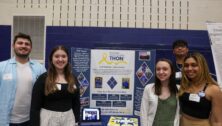WCU Professor’s New Research Method Explores Secrets of Human Speed

 As one of three developers of a new research method for measuring how sprinters attain their top speeds, West Chester University’s Kenneth Clark, an assistant professor of kinesiology, may have helped scientists uncover a secret of the world’s fastest man, Usain Bolt.
As one of three developers of a new research method for measuring how sprinters attain their top speeds, West Chester University’s Kenneth Clark, an assistant professor of kinesiology, may have helped scientists uncover a secret of the world’s fastest man, Usain Bolt.
Researchers using Clark’s two-mass model of running mechanics recently discovered that Bolt may be taking advantage of an asymmetrical running gait, according to a EurekAlert! report from Southern Methodist University.
[uam_ad id=”58459″]
Advertisement
“Our observations raise the immediate scientific question of whether a lack of symmetry represents a personal mechanical optimization that makes Bolt the fastest sprinter ever or exists for reasons yet to be identified,” said researcher Andrew Udofa.
The two-mass method allows scientists to measure ground reaction forces through mere observation, rather than the traditional use of direct sensors on the running surface — typically a special treadmill, the article explained.
“The two-mass model provides us with a new tool for assessing the crucial early portion of foot-ground contact that is so important for sprinting performance,” Udofa said.
Read more about the origins of Clark’s two-mass research method and its use in the Usain Bolt discovery on EurekAlert! here.
[uam_ad id=”63083″]
Connect With Your Community
Subscribe to stay informed!
"*" indicates required fields









































![95000-1023_ACJ_BannerAd[1]](https://vista.today/wp-content/uploads/2023/03/95000-1023_ACJ_BannerAd1.jpg)






